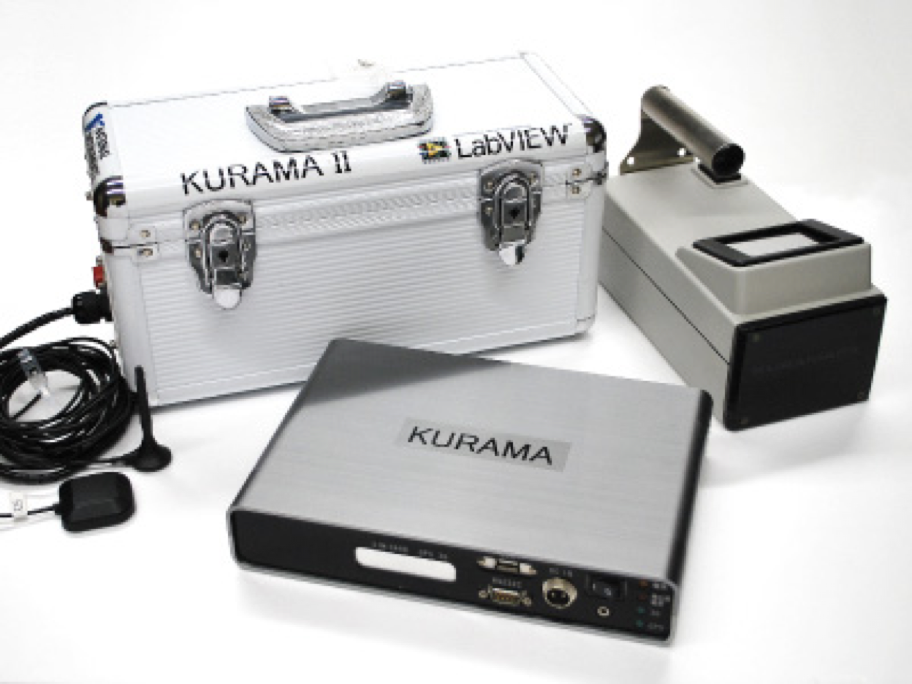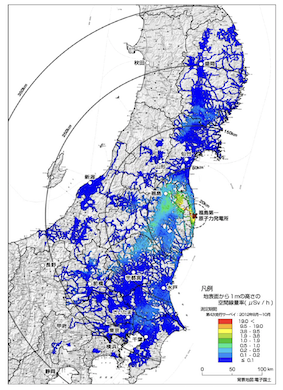KURAMA Overview

KURAMA is a system that measures information on radiation as well as positional information while moving and was developed to realize the so-called "automobile driving survey.KURAMA, which was developed immediately after the accident, was transitioned to KURAMA-II, which was fully automated and capable of collecting spectral data, within the same year, and all currently in operation are KURAMA-II. Although many systems measure radiation levels while moving, "KURAMA" and "KURAMA-II" are unique in that they are designed to be used in large-scale surveys in emergencies, and they take care to reduce the burden on users and minimize data damage and loss of measuring instruments through real-time data sharing and full automation (KURAMA-II) using cloud computing.
This section provides an overview of the KURAMA-II system in use today.
System configuration

In the KURAMA-II system, onboard equipment measures radiation, and the data is tagged with time and location information, and transmitted to the cloud via an LTE line. The sent data is registered in a database on a server system configured on the cloud and then used in various ways depending on the purpose. In addition to general visualization of radiation levels on a map, data sharing through ownCloud, an open-source file-sharing system, and integration with other existing radiation monitoring networks can be implemented according to the wishes of the implementing sites. By operating the server functions in the cloud, we have not only ensured system redundancy but also succeeded in achieving scalability, allowing investigations ranging from a single unit to 100 units to be conducted using the same procedures.
Onboard device

It is the onboard device that measures radiation and transmits the data. The device is equipped with the C12137 series, a CsI(Tl) detector manufactured by Hamamatsu Photonics. This detector is characterized by the use of a semiconductor device, MPPC, as the light-receiving element, which is smaller, lighter, and more shock-resistant than conventional photomultiplier tube detectors, and can be operated via USB bus power. Data from the C12137 is output via USB and sent to a small embedded computer, the CompactRIO from National Instruments.CompactRIO processes radiation data and tags with GPS data. Detectors are connected via USB, making it easy to add multiple detectors.CompactRIO's versatile interfaces and expansion slots can also be used to simultaneously perform other physical measurement measurements. The G(E) function method is used to calculate radiation dose. Programs running on CompactRIO are written in LabVIEW from National Instruments.LabVIEW supports Windows/macOS/Linux, making it possible to run KURAMA-II on a notebook PC, for example.
Spectral data acquisition

One of the features that distinguish KURAMA-II is its ability to collect spectral data. Radiation effects depend on its type (α, β, γ rays, etc.), energy, and the number of particles of incident radiation. Therefore, it is important to measure how much radiation of which energy came.KURAMA-II's onboard device collects the energy and number of γ-rays measured and generates spectral data, which is then transmitted together with the ambient dose equivalent rate calculated by the G(E) function method. Therefore, it is possible to reproduce the radiation field at that time by specifying the time and location on the cloud side, and it is possible to know not only what kind of radionuclides were flying and to what extent, but also the air absorbed dose rate at that time by reapplying the G(E) function to the obtained spectral data, for example. The data can also be used to re-evaluate the exposure of people to radiation or to estimate what kind of exposure they would have been exposed to if they had been there.
Communication Method
In the event of an emergency, the LTE line used by KURAMA-II is not expected to be fully functional. In general, data transmission by FTP is widely used in monitoring systems, but there is a problem that it does not function well when the communication line is not stable. Therefore, KURAMA-II implements a communication method using Web Service so that maximum data transmission is possible even in unstable communication environments. Transmissions are broken up into very small data files and sent automatically when communication is possible. Files that cannot be sent are retained in CompactRIO's memory until they are sent, and an attempt is made to send them when the communication status improves. Stable data transmission has been confirmed even in operations that are repeatedly out of range, especially in mountainous areas.
Various operational achievements

KURAMA has been used for various research activities, starting with a survey conducted by the Ministry of Education, Culture, Sports, Science, and Technology in June 2011, and is also being introduced by the national and local governments to prepare for nuclear disasters. Here are links to some examples of its use.
- Radiation Dose Distribution Map(Ministry of Education, Culture, Sports, Science and Technology, Nuclear Regulation Authority since June 2011)
Select a car from the icons on the right side of the map page. You can also use the slide bar to overlay historical data or data from other aircraft. - Continuous monitoring by bus routes, etc.(Japanese)(Fukushima Prefecture, Kyoto University, JAEA since 2013)
Continuous monitoring activities by approximately 60 KURAMA-IIs mounted on buses and other vehicles in Fukushima Prefecture. Measured data are mapped on a weekly basis and made publicly available. - Mounting on emergency monitor vehicles (Japanese)(Tottori Prefecture, 2019) A case in which a customized version of KURAMA-II was introduced for the renewal of a monitoring car.
- Series of Radioactivity Measurement Methods No.17 "Environmental γ-ray Measurement Methods by Continuous Monitoring" (Nuclear Regulation Authority, 2017) The findings from KURAMA-II measurement activities have been consolidated and systematized, and are included as information in the traveling survey.
Promotion of dissemination
To prevent monopolization of the technology and promote its diffusion and use in society, KURAMA and related technologies are protected by patents with Kyoto University as the right holder and are commercialized under a non-exclusive license to the implementing companies. The current implementing company is Matsuura Denkosha(Japanese) and manufactures which sells various types of Krama/Krama-II.